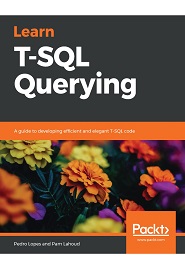
English | 2019 | ISBN: 978-1789348811 | 484 Pages | PDF, EPUB | 1190 MB
Troubleshoot query performance issues, identify anti-patterns in code, and write efficient T-SQL queries
Transact-SQL (T-SQL) is Microsoft’s proprietary extension to the SQL language that is used with Microsoft SQL Server and Azure SQL Database. This book will be a useful guide to learning the art of writing efficient T-SQL code in modern SQL Server versions, as well as the Azure SQL Database.
The book will get you started with query processing fundamentals to help you write powerful, performant T-SQL queries. You will then focus on query execution plans and learn how to leverage them for troubleshooting. In the later chapters, you will learn how to identify various T-SQL patterns and anti-patterns. This will help you analyze execution plans to gain insights into current performance, and determine whether or not a query is scalable. You will also learn to build diagnostic queries using dynamic management views (DMVs) and dynamic management functions (DMFs) to address various challenges in T-SQL execution. Next, you will study how to leverage the built-in tools of SQL Server to shorten the time taken to address query performance and scalability issues. In the concluding chapters, the book will guide you through implementing various features, such as Extended Events, Query Store, and Query Tuning Assistant using hands-on examples.
By the end of this book, you will have the skills to determine query performance bottlenecks, avoid pitfalls, and discover the anti-patterns in use.
Foreword by Conor Cunningham, Partner Architect – SQL Server and Azure SQL – Microsoft
What you will learn
- Use Query Store to understand and easily change query performance
- Recognize and eliminate bottlenecks that lead to slow performance
- Deploy quick fixes and long-term solutions to improve query performance
- Implement best practices to minimize performance risk using T-SQL
- Achieve optimal performance by ensuring careful query and index design
- Use the latest performance optimization features in SQL Server 2017 and SQL Server 2019
- Protect query performance during upgrades to newer versions of SQL Server
Resolve the captcha to access the links!